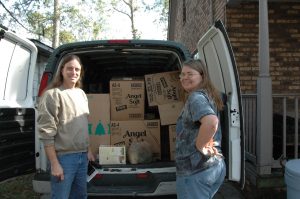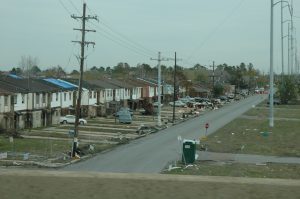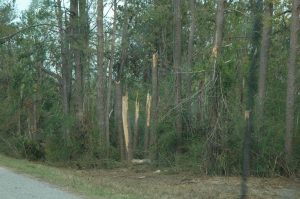Last December I flew from California to Florida to see a friend of mine, Deborah Graham, partly to spend some quality time together, but mostly to help her in her ongoing personal efforts to help victims of Katrina who have fallen through the cracks and been ignored by traditional relief agencies.

Deb has made several delivery runs to effected areas, filling specific wish lists from local agencies based upon real needs from real people. The key factor in this personal crusade has been Deb’s determination to provide support to those who have been forgotten by FEMA, the Red Cross and others. My visit was to lend her some support of her own, and to participate in a delivery run to New Orleans.
This trip was actually my second visit to New Orleans, my first visit being about two years ago. As you can imagine, the contrast between the two experiences is beyond measure. The lasting impressions I have about this visit are both subtle and obvious, and disturbing overall. First of all, the devastation in New Orleans created by Hurricane Katrina and by the broken levees is vast, far beyond anything I could have imagined. It’s not just the damage itself. It is the scope of the damage, with mile after mile of abandoned apartments, businesses, and shopping malls.

Driving into New Orleans at night was more than a little unsettling. It was raining, for one, and nearly impossible to see the lines on the road because the highway did not have reflective paint or raised dots marking the lanes. Looking off to the surrounding areas did nothing to alleviate the tension of the drive because everywhere it was dark and desolate. The few lights in the suburbs of New Orleans were obviously utility lamps powered by generators. Darkness was everywhere in places that had once been full of life and vitality.
Wreckage was everywhere, too, testimony to the destructive power of wind and water unchained. Even four months after the hurricane, there were still boats scattered across the landscape, carried far inland from the waterways. Likewise, abandoned cars, some of them overturned or filled with mold, sat as graphic reminders of lives interrupted. And everywhere trees, some of them hundreds of years old, lay broken, twisted, dead or dying. You see, the water that flooded New Orleans was not fresh water. It was sea water, and the few trees that were not killed by the salt outright now struggle to live.
We take for granted the green of trees and plants and landscapes and gardens. I know that when I think about my first visit to New Orleans my memories are filled with ancient oak trees and cultured gardens. The floodwaters changed all that. Now the city is drab, its colors muted and its flora lifeless and decaying. One resident said he felt trapped in a horror movie when he first returned home. All the colors were grey or sepia tones, and the streets completely deserted. Everything was so surreal that he expected to see zombies coming after him at any moment.

But most telling was the edginess of the people left in these areas. Journalists love to talk about people’s haunted expressions, eyes glazed, etc. That wasn’t the case when I was in New Orleans, but what I did see was every bit as disturbing. It was more of an undercurrent, elusive yet pervasive, and it flowed through everyone we met. Even when they laughed, there was a grim wretchedness behind their eyes, as though they had been stretched too far and had given up all hope of relief from their waking nightmares. And there was a brittleness to their behavior, lacing their conversations and their actions, like they were holding on to normalcy by sheer power of will. And so they are. Even those who still have houses and jobs are faced daily with the reality that their lives are gone. The places they frequented are destroyed or damaged, the people they knew either dead or evacuated. Nothing is untouched, and that reality works on the soul like an insidious poison, eating away at the most hardy of spirits over time.
Rebuilding is possible, of course, but it will take years, maybe decades before New Orleans is restored to anything like its former vivaciousness. It will never be the same – that’s a given. But recovery is possible. In the mean time, the residents and workers who strive to make a dent in the devastation need as much support and encouragement as possible. Their tasks require more than just strength of the body. They require determination and fortitude, and a good dose of sheer cussedness probably helps, too.
We spent two days in New Orleans, then we headed north to try hooking up with folks from Prentiss, MS, where Deb had made a prior delivery. Unfortunately, we weren’t able to connect with anyone as we had hoped, but I am still glad for the trip through Mississippi, if only for the fact that I saw how the hurricane damage extends far, far beyond New Orleans.
I had never been to Mississippi before, so I can only imagine what the landscape was like before Katrina. Even so, I was impressed by the rolling hills and pine forests. I never knew how beautiful the land there is, and that realization made the damage all the more striking.

For miles we drove, with tall, straight trees on either side. Then we would pass a stretch where six to a dozen trees were all snapped off at the same level. Then things would return to normal for a while, until we got to a cluster of trees that were twisted, or mashed down as if a giant foot had stepped on them. A few miles later there would be damaged road signs, or a bill board stripped of everything and left nothing more than a bent and mangled framework. All the damage seemed randomly placed, with miles of untouched forest in between. But where there was damage, it was major, with buildings crushed like egg cartons, and trees uprooted, misshapen, toppled and twisted like so much straw in the hands of a malicious child.
The damage was, if anything, made more impressive by the amount of clean-up that had obviously been done and that was still in progress as we drove. In several places there were mounds of chipped wood, the remains of acres of trees that had been cleared and collected, then mulched as part of the rebuilding process. Even in Prentiss, over a hundred miles inland, the damage was obvious and extensive, with trees toppled over buildings and the pervasive blue of tarped roofs.
I wish I could say more about Prentiss and the people of Jefferson-Davis County, but we just weren’t able to connect with folks there as intended. And I had a plane to catch the next day, so we left Prentiss, driving through the night back to Florida, Deb’s silhouette periodically lit by the glow from her cigarette while we talked about our impressions, what we had seen, and what remains to be done.
Even now, weeks later, I still struggle with my feelings about this trip. I want to do more to help, but I don’t have the luxury of being able to drop my existing responsibilities. I want to go back, to do something to lend a hand in this time of need, but I won’t return to New Orleans or to Prentiss unless I can do something or bring something to help people living there. They are the true heroes in this time of trial, and while I do not envy them, I do respect and admire them for their courage, determination, and resolve.
Blessings to you all.
~B~